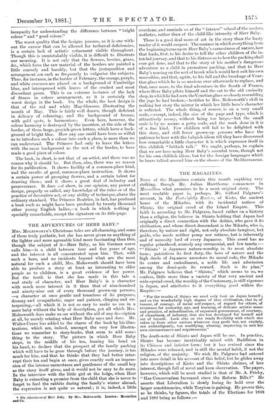A PRINCESS'S "BIRTHDAY BOOK."f'
FEW critical matters are harder to decide justly than those which turn upon the reception that should be given to the- works of those exalted personages whose position in the world renders their efforts noteworthy, apart from the merit or de- merit of their productions. It is difficult for the critic not to. feel the glamour of Royalty, more difficult still to remember,. what is the truth, that high rank in an author unconsciously irritates men of letters, who are instinctively, as regards their art, Republican. The simple course is, we think, the right one, —either to let the book alone, or treat it like any other. The- Princess's Biethday Book is, then, a small quarto volume, bound in yellow, with an elaborate gold design upon the cover, con- taining a blank page for every day in the year, with the date- as a heading, and a very thin border in two colours. The- beginning of each mouth is marked by a design, elaborately executed in gold and colours, which surrounds a few lines of • poetry appropriate to the month. There are consequently twelve designs illustrative of the twelve months, to which must be added a page which contains Her Royal Highness's mono- • gram, and one which forms .the frontispiece, and depicts the flowers of every season interwoven with one another.
The object of the book is signified by its name. It is one of those volumes in which too kindly friends are requested to jot down their names and date of birth, together with any little copy of verses, sketch from nature or imagination, or high-souled thought, of which they may happen to be capable. It is, in fact,_ the well-known and much-dreaded torture-book, minus the irritating questions, and plus some decorative borders. May we here enter one word of protest against the present revival of this system of album-torture ? In the days before railways and photographs, and, in point of fact, Universal Enlightenment, it was perhaps allowable for a young lady to demand from each of her friends some literary or artistic token by which she might remember them, and instruct or amuse herself ; but now that she can procure as much mental food as her soul can possibly as- similate at an almost nominal price, surely, surely, she may
" Spare the poor Patrician' his only joy in life,"
—the joy of being able to spend ten minutes in his friend's draw-- ing-room, without being called upon to rack his weary brains for something new.
And now comes the question,—What is the worth of this special specimen of torture-books ? There is no occasion for either blame or praise. The book is precisely such as might have been expected from any young lady who had been carefully taught flower-painting, without having possessed much special aptitude for it. The designs are neither worse nor better than the average young-lady designs ; their execution, if we may judge from the reproduction, possesses all those qualities of grace and feebleness that we are accustomed to consider typical of ladies' art. There is the same confusion of idea between what is decorative flower-painting and what is natural flower-painting- that we always meet, when amateurs attempt to treat flowers. decoratively. There is the usual ignorance of the principles of design, there is the usual lack of accurate form, and the usual
• A Birthday Book. By the Princess Beatrice. London: Smith, Elder, and Co.
incapacity for understanding the difference between " bright colour " and " good colour."
The worst quality that the designs possess, as it is one with- out the excuse that can be allowed for technical deficiencies, is a certain lack of artistic refinement visible throughout. Though this is unmistakably visible, it is difficult to illustrate our meaning. It is not only that the flowers, berries, grass, &c., which form the raw material of the borders are painted a little coarsely and harshly, but that the juxtaposition and arrangement are such as frequently to vulgarise the subjects. Thus, for instance, in the border of February, the orange, purple, and white crocuses are placed on a backgrouud of Cambridge blue, and interspersed with leaves of the crudest and most discordant green. This is an extreme instance of the lack of fitness in colour arrangement, as it is certainly the worst design in the book. On the whole, the best design is that of the red and white May-blossom, illustrating the month of May. This is fairly well drawn, though deficient in delicacy of colouring ; and the background of bronze, with gold spots, is harmonious. Even here, however, the colour harmony is destroyed by the insertion, at the side of the border, of three large, greyish-green letters, which have a back- ground of bright blue. How any one could have been so wilful as to introduce such a colour into such a place, is more than we can understand. The Princess had only to leave the letters with the same background as the rest of the border, to have made a good piece of colour.
The book, in short, is not that of an artist, and there was no reason why it should be. But then, also, there was no reason for its publication. It shows facility of a common-place kind, and the results of good, common-place instruction. It shows a certain power of grouping flowers, and a certain talent for drawing them ; and it shows a great deal of industry and perseverance. It does 410g show, in our opinion, any power of design, properly so called, any knowledge of the rules or of the practice of decorative art, or any ability of technique, above the ordinary standard. The Princess Beatrice, in fact, has produced a book such as might have been produced by twenty thousand other young English ladies,—a book in which nothing is specially remarkable, except the signature on its title-page.







































 Previous page
Previous page